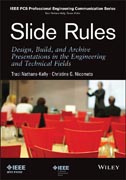
Drawing on the latest research in cognitive psychology combined with experience gained from years of successfully teaching high–level engineers, scientists, military people, and technical professionals, this book sets clear guidelines for presentation excellence. From planning for a variety of audiences (from the general public to non–technical high–influence leadership to other technical specialists) to archiving the slide deck as a living document in your organization, this full–color illustrated book will step engineering and technically oriented readers through their development as outstanding technical presenters. INDICE: Dedication Acknowledgements Foreword Introduction Slide Rule #1: Revisit Presentation Assumptions Chapter 1: Head the Pleas for Better Presentations Know the enemy Be an agent of change Call a meeting instead of summoning a slide deck Destroy the decks of drudgery Learn communication lessons from past tragedies Sidebar: From the Trenches Confront conventional poor practices Consider slides as a two–part deliverable Implement your own continuous improvement Chapter References Chapter 2: Apply Cognitive Science and Tell a Story Change presentation practices using grounded research Stay open to change Revisit how a slide works Design slides for the audience’s cognitive load Lessen cognitive load with storytelling Apply science and storytelling Chapter References Chapter 3: Understand Audience Needs Scope content towards identified purpose Sidebar: From the Trenches Learn about your audience first Determine the presentation’s purpose Determine the goals for a talk Elevate the moment Sidebar: From the trenches Assess the audience Prepare for a familiar audience Sidebar: From the Trenches Prepare for an unfamiliar audience Coping when your talk gets hijacked Ditch the “dumb it down” attitude Think of audience needs, not yours Think about logistics Chapter References Chapter 4: Challenge Your Organization’s Culture of Text–Heavy Slides Understand the pattern’s origin Stop assuming they want to read Sidebar: Notes from a Novice Work towards fewer bullets, less text Avoid using slides as teleprompters Build information deliberately Move beyond “How many slides should I use?” Encourage better presentation practices Create, compile, organize, and stabilize team presentations Work towards a change Chapter References Slide Rule #2: Write Sentence Headers Chapter 5: Clarify Topics with Full–Sentence Headers Write full sentences for headers, avoiding fragments Consider the case against fragmented headers Deploy best practices for sentence headers Expect immediate results Write targeted headers Influence outcomes with headers Frequently asked questions about sentence headers Chapter References Slide Rule #3: Use Targeted Visuals Chapter 6: Build Information Incrementally Build something better than bullets Devise methods that build information Design with words to make bullet lovers happy Solidify complex topics with refrains Use refrain slides for meeting agendas Build visuals for directed comprehension Build out to drill down Chapter 7: Generate Quality Graphs Portray complexity simply Determine the right visual Sidebar: The value of visualization Design reasonable pie charts Design impactful bar charts and histograms Sidebar: Transformation—Creating quality bar charts Design scatter XY charts and scatter plots Sidebar: Transformation—A chart grows up Craft line charts Map out area graphs Think through flow or process charts Address assorted other visual outputs Graph ethically Create accessible graphs Sidebar: Testing graphics for color–blindness accessibility Frequently asked questions about graphs Chapter References Chapter 8: Picture the Possibilities Picture your information Center yourself Manage image interpretation Model accurately Be ethical with visuals Frequently asked questions about using pictures Chapter References Chapter 9: Temper the Templates See the possibilities in a template, branded or otherwise Discover and assess a branded template Work with company templates Devise solutions for problematic templates Fix the template Provide template guidance Refine quad slides Establish brand when there is no template Chapter References Slide Rule #4: Archive Details for Future Use Chapter 10: Make Slide Decks with Archival and Legacy Value Understand that slides have two lives Start new best practices Document ideas efficiently Use the Notes or Presenter Notes feature Get others to see your notes Sidebar: Caution—The Inside doc/Outside doc Use hidden slides Keep hidden slides ready Make retrieval easy for everyone else Embrace full documentation as a part of workflow Chapter References Chapter 11: Include More Than One Language Know when English is not enough Start with audience analysis Anticipate formatting for translations Deploy plain language Write in one language and talk in another Design split slides Capture translation in notes Translate towards clarity Find resources Chapter References Slide Rule #5: Keep Looking Forward Chapter 12: Enact Organizational Change Listen to the studies Anticipate the stages of acceptance Tally the results Look for the opportunities Chapter References Chapter 13: Thinking Through the Next Big Thing See ahead Play with Prezi Use caution Amaze with Autodesk Apply apps Remain diligent in your best practices
- ISBN: 978-1-118-00296-4
- Editorial: Wiley–Blackwell
- Encuadernacion: Rústica
- Páginas: 232
- Fecha Publicación: 21/03/2014
- Nº Volúmenes: 1
- Idioma: Inglés
- Inicio /
- /
